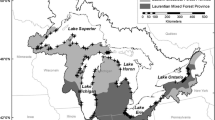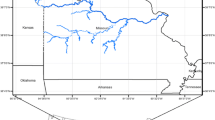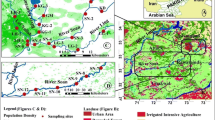Abstract
Three methods for assessing the relationships between estuarine sediment contaminant levels and watershed Stressors for 25 Chesapeake Bay sub-estuaries were compared. A geographic information system (GIS) was used to delineate watersheds for each sub-estuary and analyze land use pattern (area and location of developed, herbaceous and forested land) and point source pollution (annual outflow and contaminant loading) using three landscape analysis methods: (1) a watershed approach using the watershed of the estuary containing the sampling station. (2) a ‘partial watershed’ approach using the area of the watershed within a 10 km radius of the sampling station and (3) a ‘weighted partial watershed’ approach where Stressors within the partial watershed were weighted by the inverse of their linear distance from the sampling station. Nine sediment metals, 16 sediment organics and seven metals loading variables were each reduced to one principal component for statistical analyses. Relationships between the first principal components for sediment metals and organics concentrations and watershed stressor variables were analyzed using rank correlation and stepwise multiple regression techniques. For both metals and organics, the watershed method yieldedR 2 values considerably lower than the partial and weighted partial watershed analysis methods. Regression models using Stressor data generated by the weighted partial watershed landscape analysis method explained 76% and 47% of the variation in the first principal component for sediment metals and organics concentrations, respectively. Results suggest that the area of developed land located in the watershed within 10 km of the sediment sampling station is a major contributing factor in the sediment concentrations of both metals and organics.
Similar content being viewed by others
References
Bastian, R.K. and Benforado, J. 1988. Water quality functions of wetlands: natural and managed systems.In The ecology and management of wetlands. Vol. I: Ecology of wetlands, pp. 87–97. Edited by D.D. Hookel al. Timber Press, Portland, OR.
Chesapeake Bay Program. 1994. Chesapeake Bay basin toxics loading and release inventory — Basinwide toxics reductions strategy commitment report. CBP/TRS 102/94.
Conover, W.J. and Iman, R.L. 1981. Rank transformations as a bridge between parametric and nonparametric statistics. The American Statistician 35: 124–133.
Correll, D.L., Jordan, T.E. and Weller, D.E. 1992. Nutrient flux in a landscape: Effects of coastal land use and terrestrial community mosaic on nutrient transport to coastal waters. Estuaries 4: 431–442.
Detenbeck, N.E., Johnston, C.A. and Niemi, G.J. 1993. Wetland effects on lake water quality in the Minneapolis/St. Paul metroplitan area. Landscape Ecology 8: 39–61.
Fegas, R.G., Claire, R.W, Guptill, S.C., Anderson, K.E. and Hallam, C.A. 1983. Land use and land cover digital data. Geological Survey Circular 895-E. U.S. Geological Survey, Cartographic Information Center. Reston, Virginia.
Holland, A.F., ed. 1990. Near Coastal Program Plan for 1990: Estuaries. EPA 600/4-90/033. U.S. Environmental Protection Agency, Office of Research and Development. Environmental Research Laboratory, Narragansett, RI.
Johnston, C.A., Detenbeck, N.E. and Niemi, G.J. 1990. The cumulative effect of wetlands on stream water quality and quantity: A landscape approach. Biogeochemistry 10: 105–141.
Kadlec, R.H. and Kadlec, J.A. 1979. Wetlands and water quality.In Wetland Functions and Values: the State of our Understanding, pp. 436–456. Edited by P.E. Greeson, J.R. Clark and J.E. Clark. Proc. Nat. Symp. on Wetlands, Lake Buena Vista. FL. Amer. Water Resources Assoc., Minneapolis. MN.
Karr, J.R. and Schlosser, I.J. 1978. Water resources and the land-water interface. Science 201: 229–234.
Kim, K. and Ventura, S. 1993. Large-scale modeling of urban nonpoint source pollution using a geographic information system. Photogrammetric Engineering and Remote Sensing 59: 1539–1544.
Long, E.R., MacDonald, D.D., Smith, S.L. and Calder, F.D. 1995. Incidence of adverse biological effects within ranges of chemical concentrations in marine and estuarine sediments. Environ. Mgmt. 19: 81–97.
Maidment, D.R. 1993. GIS and hydrologic modeling.In Environmental modeling with GIS. pp. 147–167. Edited by M.F. Goodchild, B.O. Parks and L.T. Steyaert. Oxford University Press. New York.
Meentemeyer, V. and Box, E.O. 1987. Scale effects in landscape studies.In Landscape heterogeneity and disturbance, pp. 15–34. Edited by M.G. Turner. Springer-Verlag, New York.
Morrison, M.L., Marcot, B.G. and Mannan, R.W. 1992. Wildlife-habitat relationships: Concepts and applications. The University of Wisconsin Press. Madison. WI.
National Research Council. 1990. Managing troubled waters: the role of marine environmental monitoring. National Academy Press. Washington, D.C.
Neff, N.A. and Marcus, L.F. 1980. A survey of multivariate methods for systematics. New York: privately published. Printed by the American Museum of Natural History, New York.
Neter, J., Wasserman, W. and Kutner, M.H. 1985. Applied linear statistical models: Regression, analysis of variance and experimental designs. Irwin. Homewood. IL.
Osborne, L.L. and Wiley, M.J. 1988. Empirical relationships between land use/cover and stream water quality in an agricultural watershed, J. Environ. Mgmt. 26: 9–27.
Pacheco, P.A. 1993. Point source methods document for the Virginian Province. National Oceanic and Atmospheric Administration. Silver Spring, MD.
Peterjohn, W.T. and Correll, D.L. 1984. Nutrient dynamics in an agricultural watershed: Observations of the role of a riparian forest. Ecology 65: 1466–1475.
Philippi, T.E. 1993. Multiple regression: Herbivory.In Design and analysis of ecological experiments, pp. 183–210. Edited by S.M. Scheiner and J. Gurevitch. Chapman and Hall, New York.
Potvin, C. and Roff, D.A. 1993. Distribution-free and robust statistical methods: Viable alternatives to parametric statistics? Ecology 74: 1617–1628.
Ritters, K.H., O'Neill, R.V., Hunsaker, C.T., Wickham, J.D., Yankee, D.H., Timmins, S.P., Jones, K.B. and Jackson, B.L. 1995. A factor analysis of landscape pattern and structure metrics. Landscape Ecology 10: 23–39.
SAS Institute. 1990. SAS/STAT User's Guide. SAS Institute Inc., Cary. North Carolina.
Schimmel, S.C, Melzian, B.D., Campbell, D.E., Strobel, C.J., Benyi, S.J., Rosen, J.S. and Buffum, H.W. 1994. Statistical Summary: EMAP-Estuaries Virginian Province-1991. U.S. Environmental Protection Agency. Office of Research and Development, Environmental Research Laboratory. Narragansett. RI. EPA/620/R-94/005.
Strobel, C.J., Benyi, S.J., Keith, D.J., Buffum, H.W. and Petrocelli, E.A. 1994. Statistical Summary: EMAP-Estuaries Virginian Province — 1992. U.S. Environmental Protection Agency, Office of Research and Development, Environmental Research Laboratory, Narragansett, RI. EPA/620/R-94/019.
Turner, M.G., O'Neill, R.V., Gardner, R.H. and Milne, B.T. 1989. Effects of changing spatial scale on the analysis of landscape pattern. Landscape Ecology 3: 153–162.
U.S. Environmental Protection Agency. 1988. Future risk: research strategies of the 1990s. U.S. Environmental Protection Agency. Science Advisory Board, Washington, D.C. SAB-EC-88-040.
U.S. Environmental Protection Agency. 1994a. Chesapeake Bay Watershed Pilot Project. EPA/620/R-94/020.
U.S. Environmental Protection Agency. 1994b. Chesapeake Bay basin toxics loading and release inventory. CPB/TRS 102/94.
Valiela, I., Foreman, K., LaMontagne, M., Hersh, D., Costa, J., Peckol, P., DeMeo-Anderson, B., D'Avanzo, C., Babione, M., Sham, C., Brawley, J., Lajtha, K. 1992. Couplings of watersheds and coastal waters: Sources and consequences of nutrient enrichment in Waquoit Bay. Massachusetts. Estuaries 15:443–457.
Wehde, M. 1982. Grid cell size in relation to errors in maps and inventories produced by computerized map processing. Photogrammetric Engineering and Remote Sensing 48: 1289–1298.
Weisberg, S.B., Frithsen, J.B., Holland, A.F., Paul, J.F., Scott, K.J., Summers, J.K., Wilson, H.T., Valente, R., Heimbuch, D.G., Gerritsen, J., Schimmel, S.C. and Latimer, R.W. 1993. EMAP-Estuaries Virginian Province 1990 Demonstration Project Report. U.S. Environmental Protection Agency, Environmental Research Laboratory. Narragansett. RI. EPA 600/R-93/006.
Whigham, D.F. and Chitterling, C. 1988. Impacts of freshwater wetlands on water quality — a landscape perspective, J. Environ. Manage. 12: 663–674.
Zar, J.H. 1984. Biostatistical analysis. 2nd ed., Prentice-Hall Inc., Englewood Cliffs, NJ.
Author information
Authors and Affiliations
Rights and permissions
About this article
Cite this article
Comeleo, R.L., Paul, J.F., August, P.V. et al. Relationships between watershed Stressors and sediment contamination in Chesapeake Bay estuaries. Landscape Ecol 11, 307–319 (1996). https://doi.org/10.1007/BF02059858
Issue Date:
DOI: https://doi.org/10.1007/BF02059858




